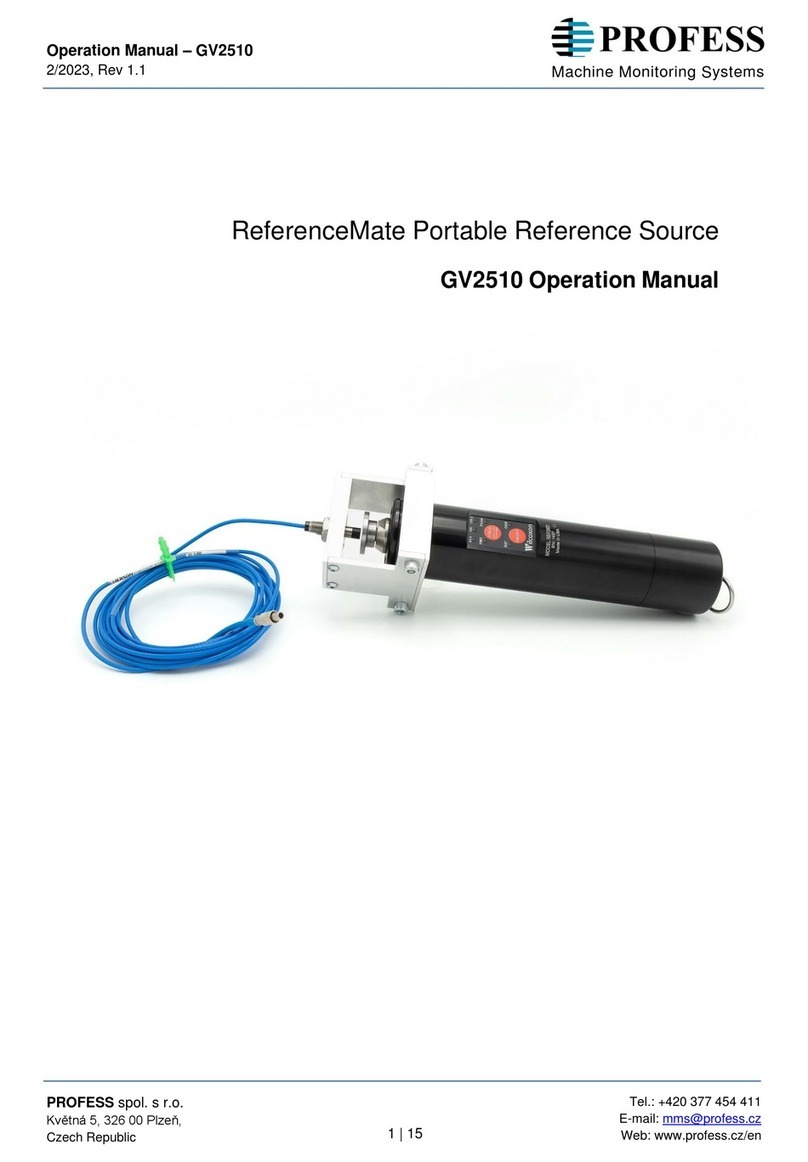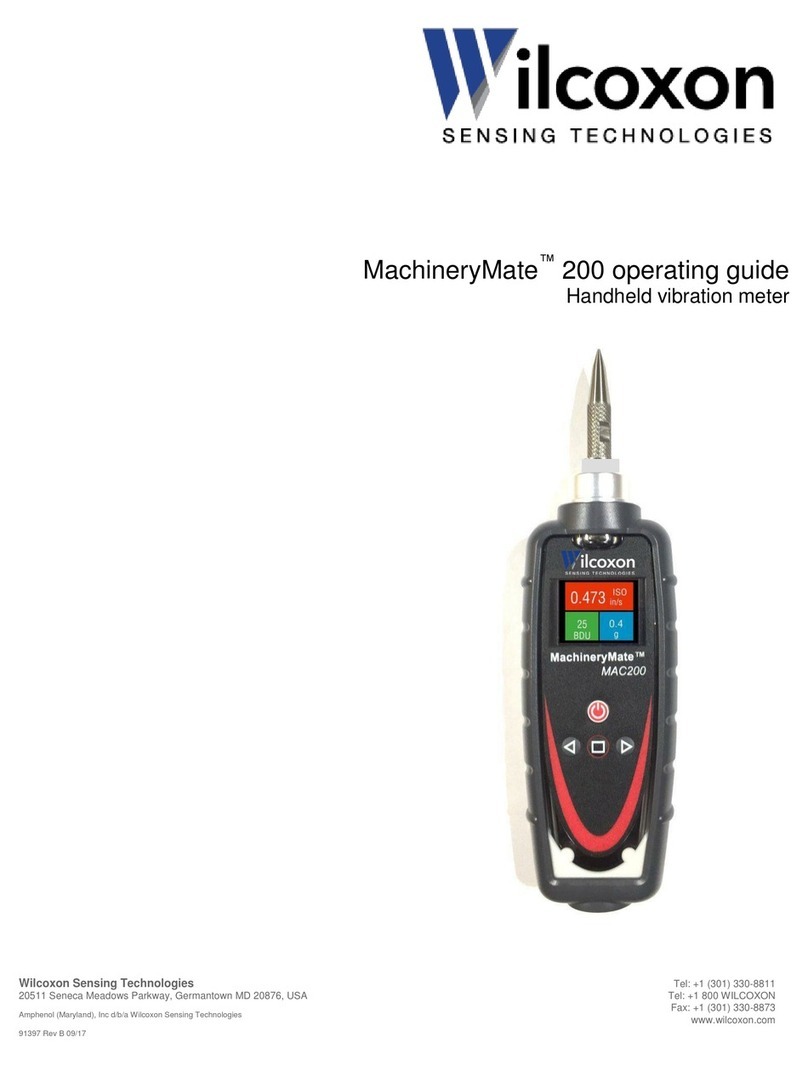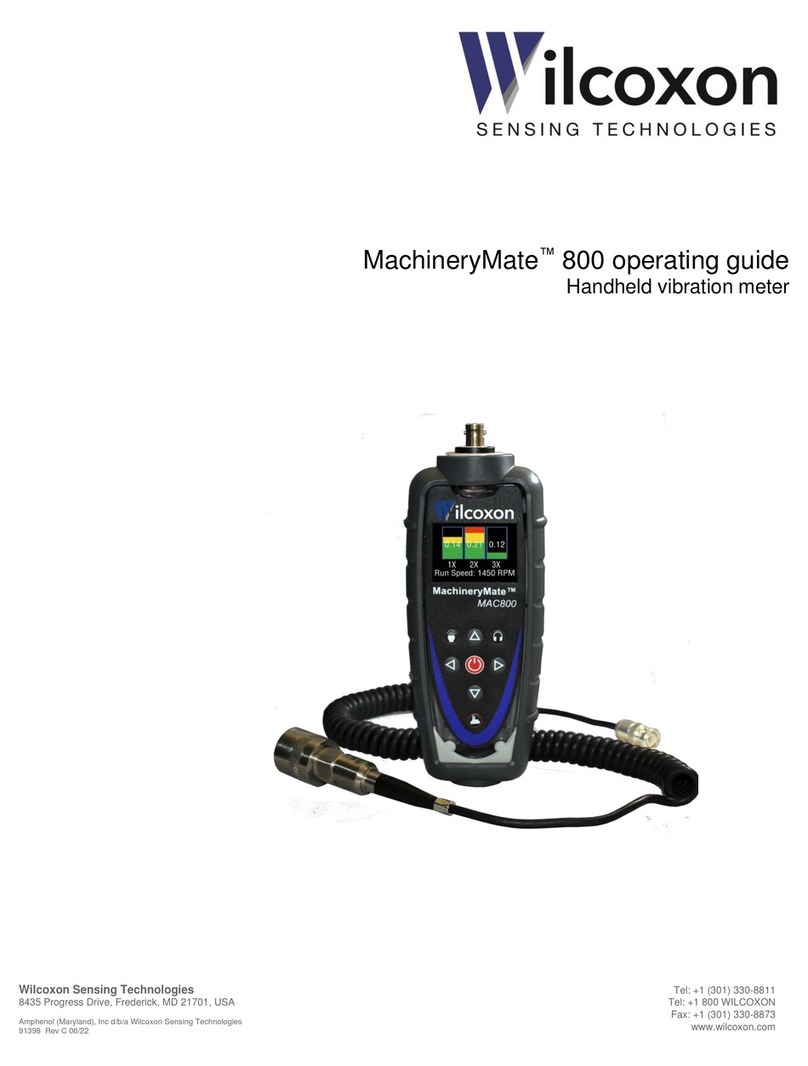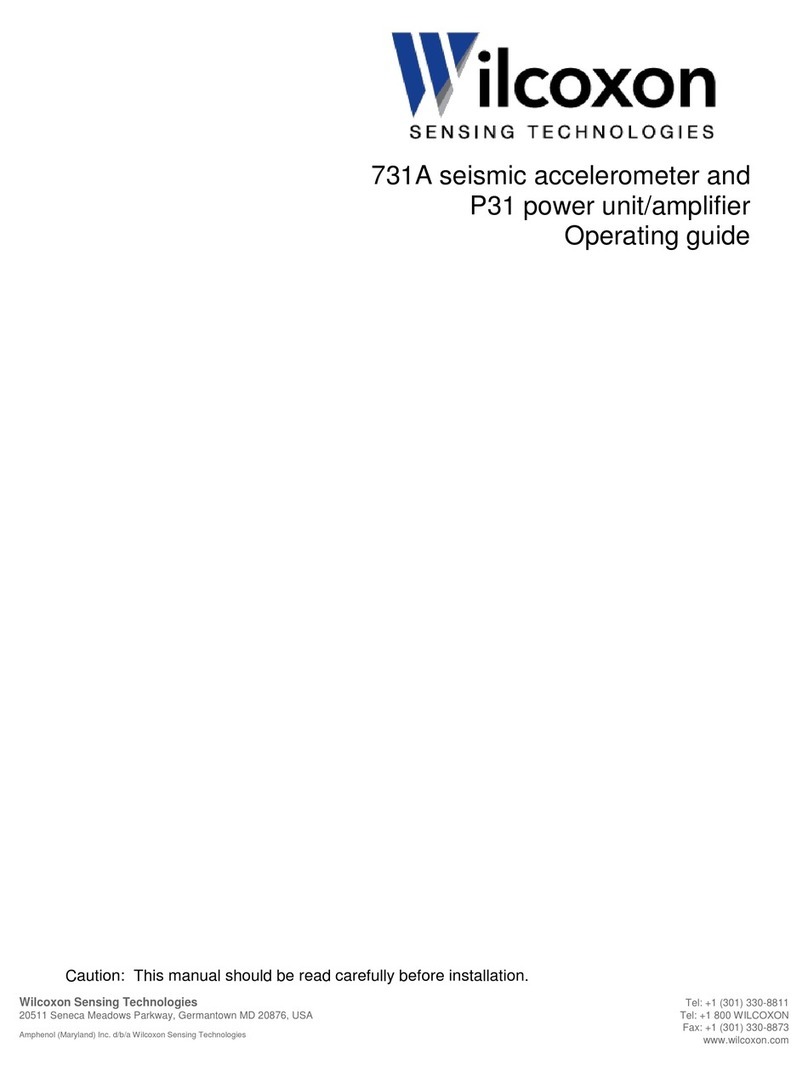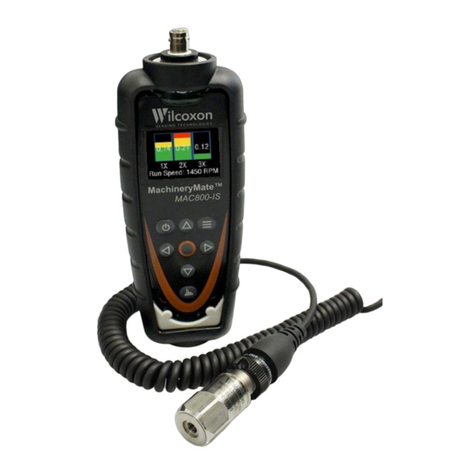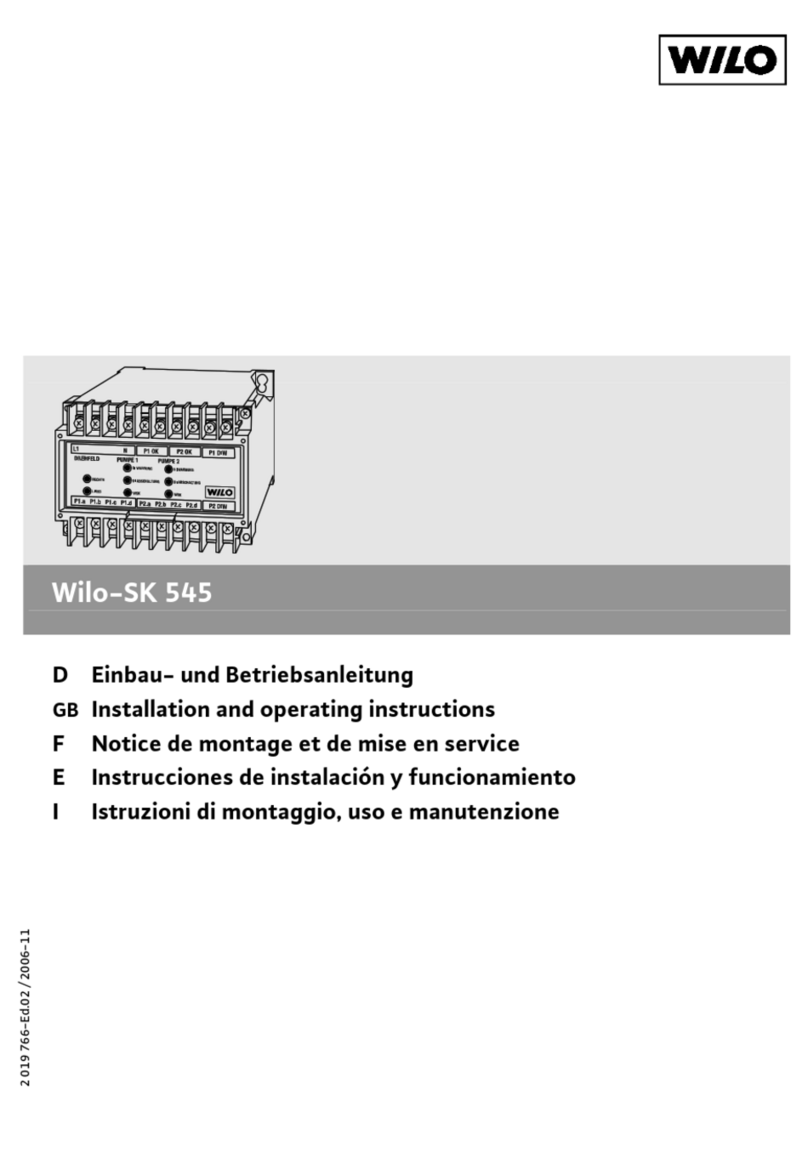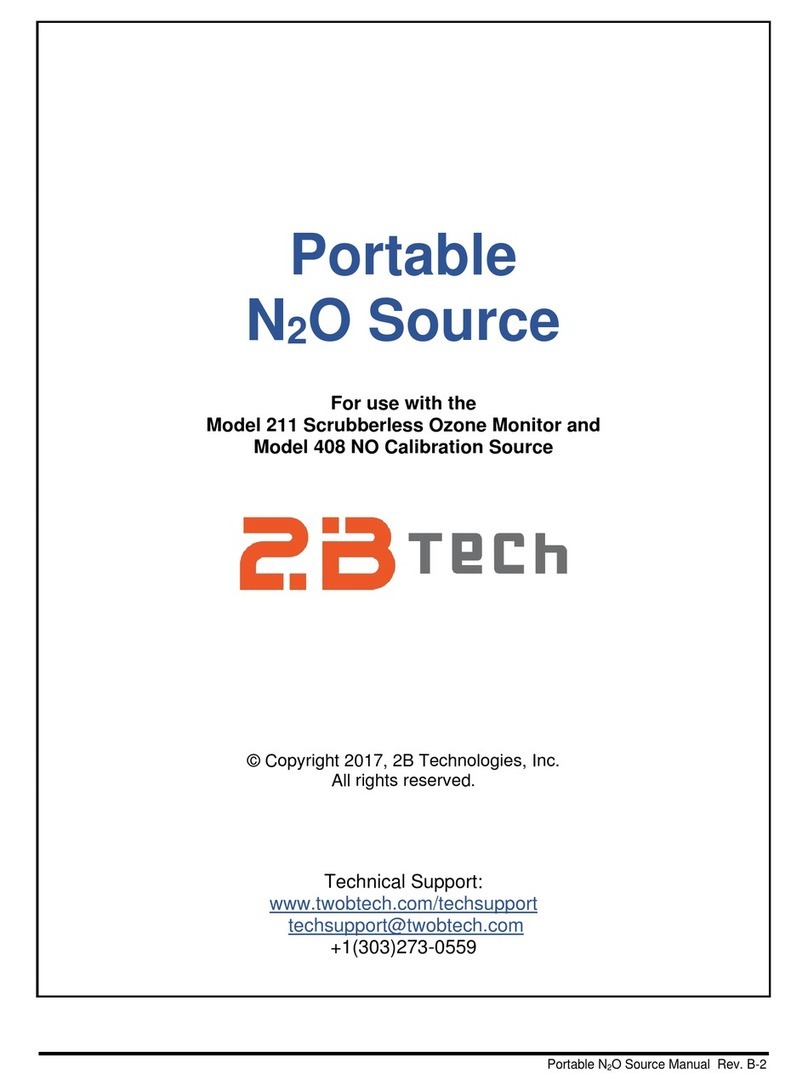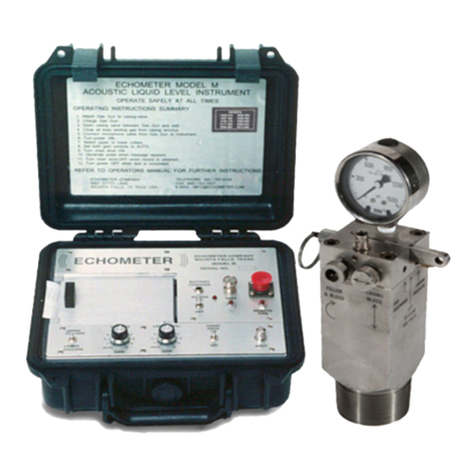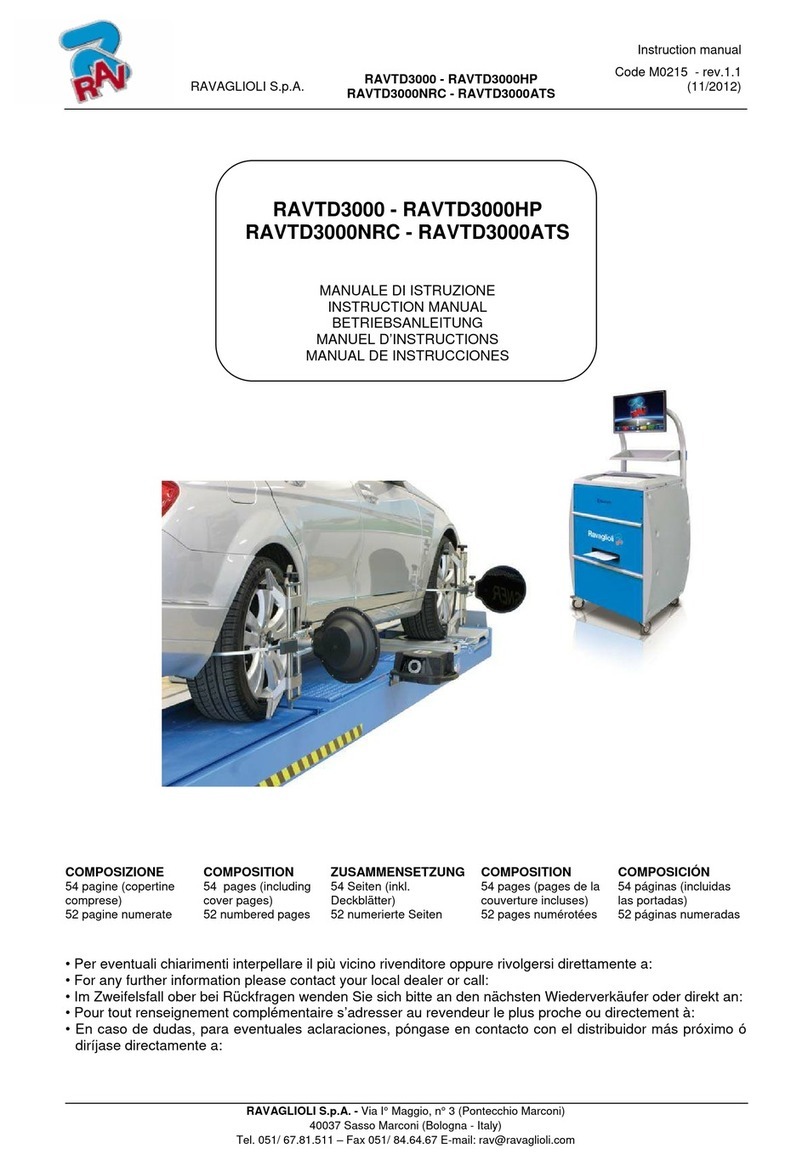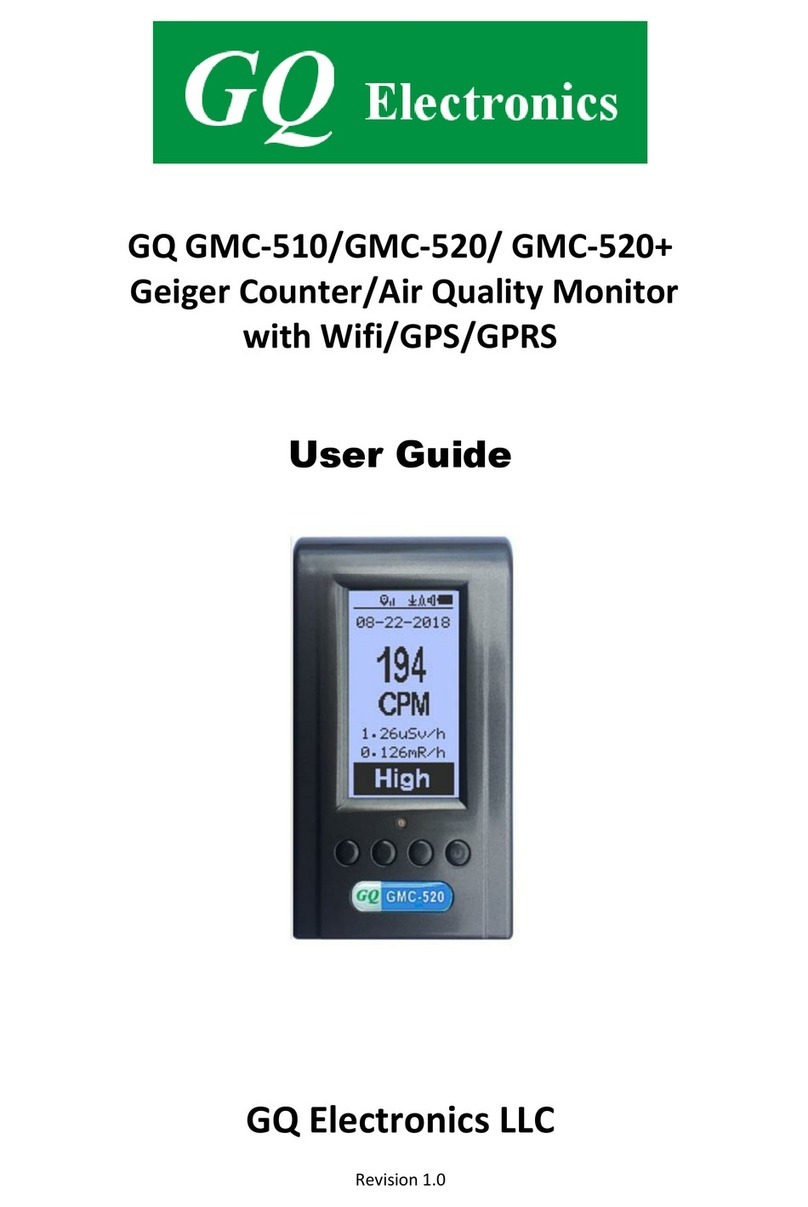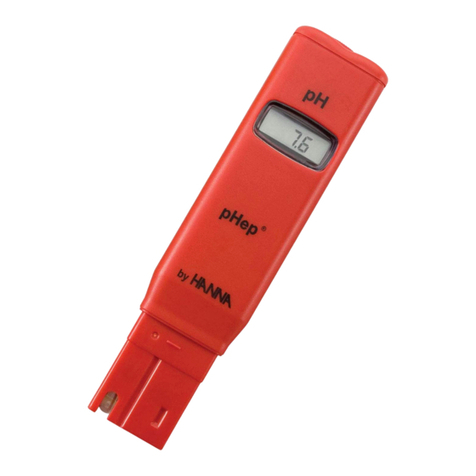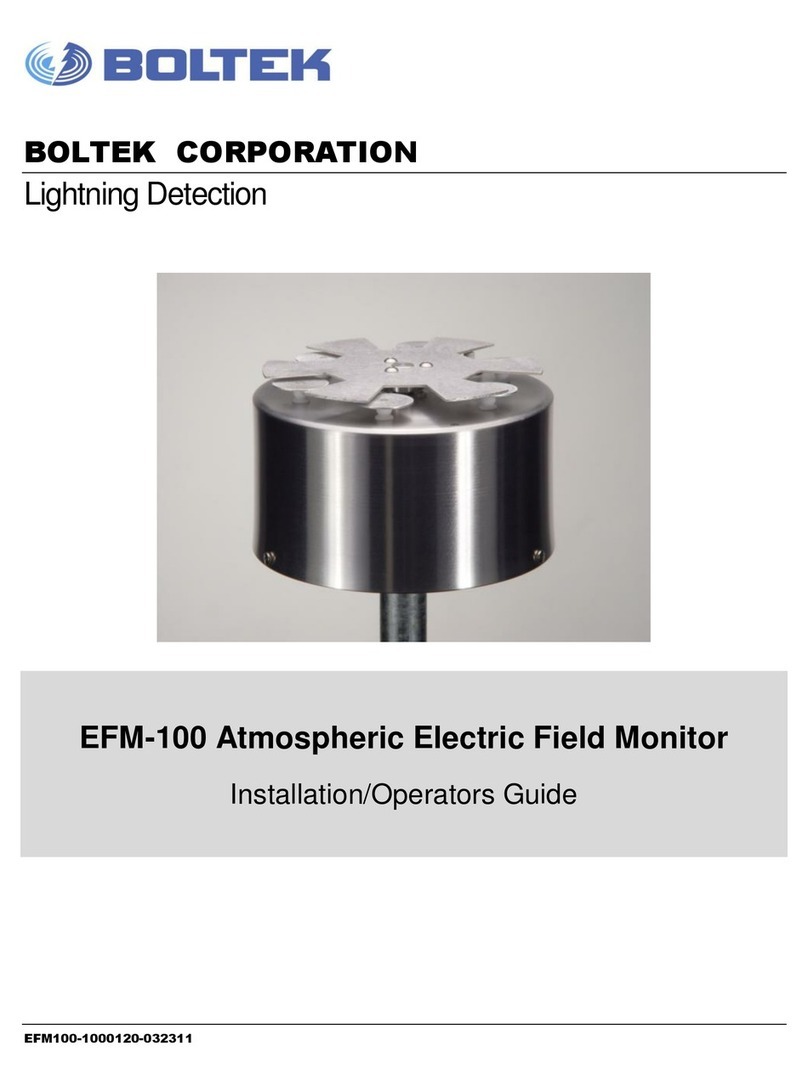Wilcoxon F-7 User manual

Wilcoxon Sensing Technologies t: 301-330-8811
8435 Progress Drive, Frederick, MD 21701 f: 301-330-8873
Amphenol (Maryland) d/b/a Wilcoxon Sensing Technologies www.wilcoxon.com
91220 Rev. F 08/2020 Page 2of 14
Table of contents
Safety section................................................................................................................3
Safety summary ............................................................................................................4
1.0 Theory of operation.............................................................................................5
2.0 Product description.............................................................................................5
2.1 Piezoelectric reaction shakers ..................................................................................... 6
2.1.1 Model F7 piezoelectric shaker ..............................................................................................7
2.1.2 Model F7-1 piezoelectric shaker...........................................................................................7
2.2 System components .................................................................................................... 8
2.2.1 Model F7 piezoelectric shaker system..................................................................................8
2.2.2 Model F7-1 piezoelectric shaker system...............................................................................8
2.3 Matching networks: theory and operation..................................................................... 8
2.4 Optional accessories.................................................................................................... 9
3.0 Initial system setup...........................................................................................10
3.1 Checking components ................................................................................................10
3.2 Mounting instructions..................................................................................................10
3.3 Connect the power amplifier .......................................................................................10
3.4 Connect the matching network....................................................................................11
3.5 Electrical connection instructions................................................................................11
3.6 Model Z7 impedance head connection........................................................................11
4.0 Operation ...........................................................................................................12
5.0 Warranty.............................................................................................................13
6.0 Technical assistance & customer service.......................................................13
Appendix: Mechanical drawings................................................................................14

Wilcoxon Sensing Technologies t: 301-330-8811
8435 Progress Drive, Frederick, MD 21701 f: 301-330-8873
Amphenol (Maryland) d/b/a Wilcoxon Sensing Technologies www.wilcoxon.com
91220 Rev. F 08/2020 Page 3of 14
WARNING: OPERATION OF THE SHAKER IS SAFE WHEN THE INSTRUCTIONS IN THIS
MANUAL ARE READ THOROUGHLY BEFORE CONNECTING TO THE POWER
AMPLIFIER. PARTICULAR ATTENTION MUST BE PAID TO THE SAFETY SECTION OF
THIS MANUAL.
WARNING: TO PREVENT FIRE OR SHOCK HAZARD, DO NOT EXPOSE THIS EQUIPMENT
TO RAIN OR MOISTURE.
WARNING: LETHAL VOLTAGES ARE PRESENT IN THE WILCOXON AMPLIFIER AND
MATCHING NETWORKS.
Safety section
The piezoelectric shakers can be safely operated when the instructions in this manual are
carefully followed.
This section summarizes the safety considerations. Reminders, in the form described below, will
appear in the detailed instructions to assure operator awareness of these safety considerations.
Qualified personnel should operate and maintain this equipment only after becoming thoroughly
familiar with this manual.
WARNING: This symbol is used in the instruction manual where operator safety
must be considered. The instruction manual should be consulted and read carefully.
CAUTION: This symbol is used when caution is needed to prevent damage to the
equipment. It is used where careful attention to certain procedures described in the
instruction manual is required. This symbol is also used to emphasize procedures
other than normal operating procedures.

Wilcoxon Sensing Technologies t: 301-330-8811
8435 Progress Drive, Frederick, MD 21701 f: 301-330-8873
Amphenol (Maryland) d/b/a Wilcoxon Sensing Technologies www.wilcoxon.com
91220 Rev. F 08/2020 Page 4of 14
Safety summary
1. Make sure that the power amplifier is properly grounded to a good earth ground.
2. Make sure that any piezoelectric shaker being driven is properly grounded to a good earth
ground.
3. Disconnect the power cord at its source before connecting or removing any cables.
4. To reduce the risk of electric shock, do not remove the power amplifier cover. No user-
serviceable parts are inside. Refer all servicing issues to Wilcoxon Sensing Technologies.
5. Do not attempt to operate a power amplifier without the protective covers secured.
6. All cables must be connected between the power amplifier, matching network and shaker
before electrical power is connected. Inspect for frayed or cut cables prior to operation.
7. Wear hearing protection when driving piezoelectric shakers at high levels and high
frequencies.
8. Do not expose this equipment to rain or moisture.
9. Lethal high voltage may be present at any of the equipment connectors.
10. Use common sense and avoid haste!

Wilcoxon Sensing Technologies t: 301-330-8811
8435 Progress Drive, Frederick, MD 21701 f: 301-330-8873
Amphenol (Maryland) d/b/a Wilcoxon Sensing Technologies www.wilcoxon.com
91220 Rev. F 08/2020 Page 5of 14
1.0 Theory of operation
The word "piezoelectricity" is derived from the Greek word "piezein" meaning "press" combined
with the word electricity. Webster's dictionary defines it as "electricity or electric polarity due to
pressure esp. in a crystalline substance (as quartz)." The piezoelectric effect is the production of
electric current from the application of pressure to a crystalline substance.
Piezoelectricity was discovered at the Sorbonne in 1880 by Pierre and Jacques Curie. Pierre,
who 18 years later collaborated with his wife in the discovery of radium, was 21 years old and
Jacques was 24 when the brothers first demonstrated the piezoelectric effect. In her biography
of Pierre, Marie Curie pointed out that the youthful discovery was not an accident but the
product of extensive theoretical and experimental study of the
symmetry of crystalline matter. Crystallographic and mathematical
relations governing piezoelectricity were developed in the few
years following the discovery. Crystals studied in this early period
included quartz, tourmaline and Rochelle salt. The Curie brothers
discovered the reverse of the piezoelectric effect in 1881. The
reverse effect is that crystals would deform from the application of
an electric field. It is this reverse effect that is employed in
piezoelectric shakers.
Since the piezoelectric effect is bi-directional, it means that piezoelectric elements can be used
to transform mechanical energy to electrical energy or vice versa. This energy transforming
property means that piezoelectric elements are transducers. Piezoelectric shakers are a specific
type of transducer, one where an electrical signal is transformed into mechanical displacement.
The displacement of the piezoelectric material is in the order of microns of motion.
Consequently, piezoelectric force generators (shakers) develop little useful acceleration in the
low frequencies. Piezoelectric generators can be used successfully for vibration excitation at
frequencies above 1,000 Hz.
2.0 Product description
Piezoelectric shakers are designed for use in the vibration test and analysis field. They utilize
the properties of piezoelectric crystals for high level sonic and ultrasonic structural excitation.
Conventional large electromagnetic shakers are limited to a frequency range of only several kHz
while piezoelectric shakers and tables allow operation past 20 kHz. Piezoelectric shakers can
be mounted on top of large electromagnetic shakers to provide both low and high frequency
capabilities in one set-up. The model F7 shaker is specifically designed to be mounted within
the central core of either the Wilcoxon F4 or F10 electrodynamic shaker.
Piezoelectric shakers consist of three main components: the head or table, the compliant
piezoelectric stack and the reaction mass. Below the fundamental resonance frequency of this
system, the output for a given input voltage is displacement controlled. For example, if the

Wilcoxon Sensing Technologies t: 301-330-8811
8435 Progress Drive, Frederick, MD 21701 f: 301-330-8873
Amphenol (Maryland) d/b/a Wilcoxon Sensing Technologies www.wilcoxon.com
91220 Rev. F 08/2020 Page 6of 14
displacement is 1 micron per 1,000 volts input, then a 1,000 volt, peak, sine wave will produce
an acceleration of 4g, peak, at 1 kHz or 100g, peak at 5 kHz. The acceleration of the table is
proportional to the square of the frequency times displacement.
Above the fundamental resonance frequency the output is force controlled. The force generated
by the piezoelectric shakers can be up to 2,000 Newton, peak (800 Vrms) by the F7 model or 50
Newton, peak (800 Vrms) by the F7-1 model.
The output of the shaker with a typical test specimen attached to the shaker or table is
dependent on the mechanical impedance of the specimen. At anti-resonances (maximum
impedance) the displacement of the shaker is at a minimum, but the specified force is delivered,
provided that the impedance of the base mass is sufficiently high. At the resonances (minimum
impedance) the shaker acceleration must be limited to the maximum specified levels for the
individual shakers. The blocked force output curves refer to the force developed against a mass
of infinite impedance. The graphs on the product data sheets for the shakers show typical
frequency response and may vary between shakers. Matching of shakers to a common first
resonance frequency is available on special order. Wide fluctuations in force output are present
at very high frequencies; however, these shakers can be used as a source of structural
excitation above 60,000 Hz.
Piezoelectric shakers present a capacitive (reactive) load to power amplifiers, therefore the
electrical impedance decreases with increasing frequency. A large power amplifier is required to
drive a shaker at maximum voltage to its maximum frequency. Smaller amplifiers may be used
to drive the shaker at maximum output at lower frequencies. Optimum operation over a range of
frequencies requires the proper impedance matching network between the power amplifier and
piezoelectric shaker.
2.1 Piezoelectric reaction shakers
Piezoelectric reaction shakers are compact, lightweight shakers that utilize the
expansion/contraction properties of piezoelectric crystals for sonic and ultrasonic structural
excitation. These portable reaction-type shakers generate large dynamic forces to very high
frequencies for structural excitation in vibration research and testing. The reactive principle of
operation combined with a lightweight and compact configuration allows these generators to be
stud-mounted in any position, directly to structures, without external support or critical shaft
alignment problems. The F7 piezoelectric vibration generator is designed to mate with the F4
electromagnetic vibration generator to extend the frequency range down to low frequencies (see
the specification sheet for model F4/F7 for details).
A transducer base is located on the model F7 and has a transducer containing a force gage and
an accelerometer. These transducers are built into the attachment point of the F7 and measure
the force applied to the structure (force gage) and the resulting vibratory motion
(accelerometer). The transducer signals can be fed into either the read-out equipment or into
signal conditioners. During the design of this base, particular attention was given to yield a
minimum mass below the force gage.

Wilcoxon Sensing Technologies t: 301-330-8811
8435 Progress Drive, Frederick, MD 21701 f: 301-330-8873
Amphenol (Maryland) d/b/a Wilcoxon Sensing Technologies www.wilcoxon.com
91220 Rev. F 08/2020 Page 7of 14
Applications for these instruments include such areas as biomedical research, production
testing, mechanical impedance studies, high frequency vibration research and other areas
where structural excitation over a wide frequency range is required.
2.1.1 Model F7 piezoelectric shaker
The model F7 piezoelectric shaker is a compact, lightweight shaker that produces large
dynamic forces to high frequencies for structural excitation. The model F7 piezoelectric shaker
is supplied with an impedance head that contains a force transducer and internal high
impedance accelerometer to monitor the force applied to the test structure and the resultant
motion.
The Wilcoxon model N7FS matching network is designed for use with the model F7
piezoelectric shaker.
The impedance head transducer base consists of a cylindrical titanium housing containing a
piezoelectric accelerometer and a piezoelectric force gauge. The transducer base is mounted
concentrically within the model F7 piezoelectric shaker.
When applying a sinusoidal force to a structure with a shaker equipped with an impedance
head, one can calculate the mechanical impedance of the structure from values of the applied
force (force gauge output) and the resulting motion at the point of force application
(accelerometer output).
2.1.2 Model F7-1 piezoelectric shaker
The model F7-1 piezoelectric shaker is a compact, lightweight shaker that produces large
dynamic forces to very high frequencies for structural excitation. The model F7-1 shaker is,
typically, used without an impedance head and produces higher frequencies than the model F7
piezoelectric shaker.
The Wilcoxon model N8HFS matching network is specifically designed for the model F7-1
piezoelectric shaker.
The model F7-1 piezoelectric shaker has a mounting base with one tapped hole, 1/4-28 UNF in
the center of the base, and four equally spaced tapped holes, 10-32 UNF, on a one-inch circle.

Wilcoxon Sensing Technologies t: 301-330-8811
8435 Progress Drive, Frederick, MD 21701 f: 301-330-8873
Amphenol (Maryland) d/b/a Wilcoxon Sensing Technologies www.wilcoxon.com
91220 Rev. F 08/2020 Page 8of 14
2.2 System components
2.2.1 Model F7 piezoelectric shaker system
The model F7 piezoelectric shaker system comes complete with the Model F7 piezoelectric
shaker, the Z7 impedance head, all input and output cables, a mounting stud, and a spanner
wrench.
2.2.2 Model F7-1 piezoelectric shaker system
The model F7-1 piezoelectric shaker system comes complete with the model F7-1 piezoelectric
shaker, all input cables, a mounting stud, and a spanner wrench.
2.3 Matching networks: theory and operation
CAUTION: If you attempt to operate a piezoelectric shaker without a matching
network, you risk serious damage to the output stage of the power amplifier
used to drive the piezoelectric shaker.
While an electromagnetic shaker presents a low, relatively constant, largely resistive
impedance, a piezoelectric shaker is essentially capacitive. This means that the impedance
presented by the piezoshaker will decrease almost linearly with increasing frequency. However,
at the shaker systems’ resonant frequency, the impedance is real and extremely low. The
matching networks include series resistance to prevent damage to the power amplifiers at
resonance. A piezoshaker creates a displacement proportional to the voltage input for
frequencies below its resonance. Therefore, in order to get maximum displacement and
consequently maximum acceleration levels at low frequencies, the voltage must be stepped up
significantly.
Note: If a constant voltage (i.e. constant displacement) independent of frequency is
generated, then the acceleration and force outputs will increase with the square (i.e. at
40dB per decade) of the frequency up to the resonance of the piezoshaker.
The impedance matching network normally consists of a step-up transformer, and an output tap
switching arrangement. A variety of output voltages are then available to maximize the voltage
delivered to the piezoshaker at different frequencies. Due to the capacitive nature of the
piezoelectric shaker, the output impedance of the power amp, and the impedance
transformation of the matching network’s transformer the voltage at the piezoelectric shaker
rolls off at 20dB per decade after the corner frequency (exactly like an RC filter). As the voltage
switch setting on the matching network is switched from highest to lowest the bandwidth of the
system will increase.
In general, the piezoshaker can be operated at their lower frequencies with the matching
network switch in its highest voltage position. The relatively low load (high impedance) of the

Wilcoxon Sensing Technologies t: 301-330-8811
8435 Progress Drive, Frederick, MD 21701 f: 301-330-8873
Amphenol (Maryland) d/b/a Wilcoxon Sensing Technologies www.wilcoxon.com
91220 Rev. F 08/2020 Page 9of 14
piezoshaker at low frequencies is not demanding and the power amplifier can maintain the high
voltage swing for maximum shaker output; however, as the operating frequency increases,
lower output voltage taps become more efficient. The greatest power requirements for the
power amplifier will occur at the corner frequencies of the matching network and shaker system
and at the resonant frequency of the shaker.
CAUTION: The piezoshakers can be damaged by internal heat build up when
run at high levels for extended periods. This is due to the dielectric loss
tangent of the piezoceramic material that generates heat. When driven at high
power levels this heat buildup will raise the temperature of the piezoceramic
to the Curie temperature where it will depolarize itself. Please contact
Wilcoxon for assistance when extended high output testing will be performed.
CAUTION: Reduce power to a minimum prior to changing switch settings.
The N7FS matching network connects to the power amplifier and provides selectable maximum
voltage outputs of 100, 200, 300, 500, and 800 Vrms. The N7FS matching network is designed
to power the model F7 piezoelectric shaker.
The N8HFS matching network connects to the power amplifier and provides a maximum voltage
output of 360 Vrms. The N8HFS matching network is designed to power the model F7-1
piezoelectric shaker.
2.4 Optional accessories
Accessories available from Wilcoxon Sensing Technologies for these systems include power
amplifiers, mounting hardware, and cables. Refer to the Wilcoxon catalog for product numbers
and ordering information.

Wilcoxon Sensing Technologies t: 301-330-8811
8435 Progress Drive, Frederick, MD 21701 f: 301-330-8873
Amphenol (Maryland) d/b/a Wilcoxon Sensing Technologies www.wilcoxon.com
91220 Rev. F 08/2020 Page 10 of 14
3.0 Initial system setup
While the piezoelectric shaker, itself, does not have any operating controls or settings, it
functions as a part of a total system for vibration excitation. This system should be checked
using the following steps for complete installation.
CAUTION: Complete all of these steps before operating the shaker system.
3.1 Checking components
After carefully unpacking the shakers and any accessories, inspect all external parts for visible
damage to the shaker or connectors. If there is damage, file a claim with the carrier who
transported the system. Retain the shipping containers and packing material for use in case
reshipment is required.
CAUTION: Do not drop the shaker. The piezoelectric shaker operating element
is a piezoelectric ceramic. The mechanical shock from dropping could
fracture the ceramic. If space permits, it is recommended that a thick piece of
protective material, such as foam rubber, be wrapped around the periphery to
prevent accidents.
Ensure that you have all components of the purchased system.
3.2 Mounting instructions
The mounting surface of the Z7 impedance head must rest flush against the test structure to
maintain transducer sensitivity. The F7-1 has no impedance head but should contact the
surface of the structure under test rigidly to insure adequate vibration energy transfer.
Do not dent shaker mounting surface when mounting to test structure.
3.3 Connect the power amplifier
Wilcoxon Sensing Technologies power amplifiers are purchased and shipped separately from
vibration generator products. Refer to the operating guide supplied with the power amplifier for
connection instructions. If using a power amplifier other than one supplied by Wilcoxon, follow
that manufacturer’s recommended procedure for installation and operation.

Wilcoxon Sensing Technologies t: 301-330-8811
8435 Progress Drive, Frederick, MD 21701 f: 301-330-8873
Amphenol (Maryland) d/b/a Wilcoxon Sensing Technologies www.wilcoxon.com
91220 Rev. F 08/2020 Page 11 of 14
3.4 Connect the matching network
Wilcoxon Sensing Technologies matching networks are purchased and shipped separately from
vibration generator products. Refer to the operating guide supplied with the matching network
for connection instructions.
3.5 Electrical connection instructions
3.5.1 Make sure that the AC line receptacle used for the power amplifier is properly grounded
to a good earth ground.
WARNING: Do not operate the system without proper grounding.
3.5.2 Decrease power to minimum before changing the matching network switch positions.
3.5.3 Before making any changes in electrical connections, turn signal input level to a minimum
and turn main power switch off on the power amplifier.
3.5.4 After the shaker system and its components are properly connected and mounted to the
test specimen, the accelerometer and force gauge outputs in the impedance head should be
connected to the proper signal conditioners and to the readout device.
CAUTION: Powering systems supplied by Wilcoxon Sensing Technologies are designed
such that the maximum input voltage cannot be exceeded. Do not exceed the maximum input
voltage to the piezoelectric shaker if another powering system is used.
3.5.5 The following table indicates the cable types and connections for the Wilcoxon Sensing
Technologies power amplifiers, matching networks, and piezoelectric shakers. This table should
be consulted for guidance as to cable and equipment connection.
Table 3.5 –Interconnecting cables
Piezoelectric shaker
Cable from power amplifier to
matching network
Matching
network
Cable from matching
network to shaker
F7
R22-22-J9B-5
N7FS
R4-4M-J9-10
F7-1
R22-22-J9B-5
N8HFS
R4-4M-J9-10
3.6 Model Z7 impedance head connection
The Z7 impedance head is an integral part of the model F7 piezoelectric
shaker. It contains a piezoelectric accelerometer and a piezoelectric force
gauge. The output from these high impedance, charge-mode sensors is
from two 10-32 coaxial (Microdot) connector jacks on the periphery of the
transducer. They are marked “A” for acceleration, and “F” for force.

Wilcoxon Sensing Technologies t: 301-330-8811
8435 Progress Drive, Frederick, MD 21701 f: 301-330-8873
Amphenol (Maryland) d/b/a Wilcoxon Sensing Technologies www.wilcoxon.com
91220 Rev. F 08/2020 Page 12 of 14
4.0 Operation
The vibration generating system is ready for operation only after it has been thoroughly checked
for proper electrical connections. The user should have selected a suitable location for the
system, preferably in a sound isolated room, since the shaker may generate a considerable
amount of sonic output.
WARNING: It is recommended that the operating personnel
use hearing protection.
The following steps are suggested for operation of the vibration generating system:
1. Make sure the oscillator amplitude control is set to a minimum or off.
2. Adjust the matching network selector switch to the lowest output amplitude setting.
3. (Optional, depending on your system configuration.) Turn on the vibration monitoring system
consisting of the accelerometer and its associated output-measuring or display instruments.
4. Turn on the oscillator and set its frequency dial to the low end of the desired frequency
range of the test sequence.
5. STAND CLEAR OF THE SHAKER DURING OPERATION.
6. Set the amplifier power switch to ON.
7. Slowly increase the setting of the signal generator amplitude control until the shaker
generates the desired vibration level or until clipping of the power amplifier output occurs.
8. (Optional, depending on your system configuration.) It is recommended to use a monitoring
system to monitor the amplifier output to prevent overdriving the shaker.
9. Continue the test by changing the oscillator frequency dial and adjusting the amplitude
control to attain the desired vibration levels.
10. When using a matching network, higher vibration levels can be obtained by turning the
signal generator output amplitude control to minimum before turning the matching network
selector switch to a higher output voltage setting when required.
11. Proceed as in steps 8 and 10 above.
12. When the test sequence is completed, turn down the signal generator output amplitude
control then turn the matching network selector switch to the minimum output position.
13. Set the power amplifier power switch to OFF.

Wilcoxon Sensing Technologies t: 301-330-8811
8435 Progress Drive, Frederick, MD 21701 f: 301-330-8873
Amphenol (Maryland) d/b/a Wilcoxon Sensing Technologies www.wilcoxon.com
91220 Rev. F 08/2020 Page 13 of 14
5.0 Warranty
Wilcoxon Sensing Technologies offers a Warranty service plan for all Wilcoxon-manufactured
products. Under this plan Wilcoxon will repair or replace any part or component that is not
operating in accordance with published specifications.
This warranty service plan does not include:
•Products improperly installed or calibrated.
•Products damaged, misused, or misapplied.
•Products not manufactured by Wilcoxon Sensing Technologies.
•Unauthorized repairs or alterations.
•Neglect or accidents.
To receive service, contact Wilcoxon for a return materials authorization (RMA) number. To
assure delivery acceptance, write the RMA number clearly and in an obvious place on the
outside of the package containing the part or component. The RMA number should be
referenced on all paperwork. Shipment to Wilcoxon must be prepaid by the customer. After
repair or replacement, Wilcoxon will return the part or component to the customer prepaid by
Wilcoxon.
This service is offered to the customer at NO CHARGE for a period of two (2) years from
shipment of the hardware from the factory. The period of this warranty service plan may vary for
specific models. At the end of this period the repair or replacement service shall be terminated.
Renewals of this basic plan will be available on selected products. The products must be
recertified or repaired to original specifications by Wilcoxon Sensing Technologies before the
service agreement can be renewed. Wilcoxon’s liability for incidental and consequential
damages is expressly excluded. THIS WARRANTY SERVICE PLAN IS THE EXCLUSIVE
REMEDY FOR CORRECTIONS OF IMPROPERLY PERFORMING PARTS AND
COMPONENTS. NO WARRANTIES, EITHER EXPRESSED OR IMPLIED, INCLUDING, BUT
NOT LIMITED TO, WARRANTIES OF MERCHANTABILITY OR FITNESS FOR A
PARTICULAR USE OR PURPOSE ARE GIVEN. If full payment on the goods is not received by
Wilcoxon Sensing Technologies, this warranty service plan is null and void.
6.0 Technical assistance & customer service
For technical assistance, please contact Wilcoxon’s application support by phone at 301-330-
8811, fax to 301-330-8873, or by email at info@wilcoxon.com.
For all customer service inquiries, please call 301-330-8811, fax to 301-330-8873, or email
info@wilcoxon.com.
This manual suits for next models
1
Table of contents
Other Wilcoxon Measuring Instrument manuals
Popular Measuring Instrument manuals by other brands
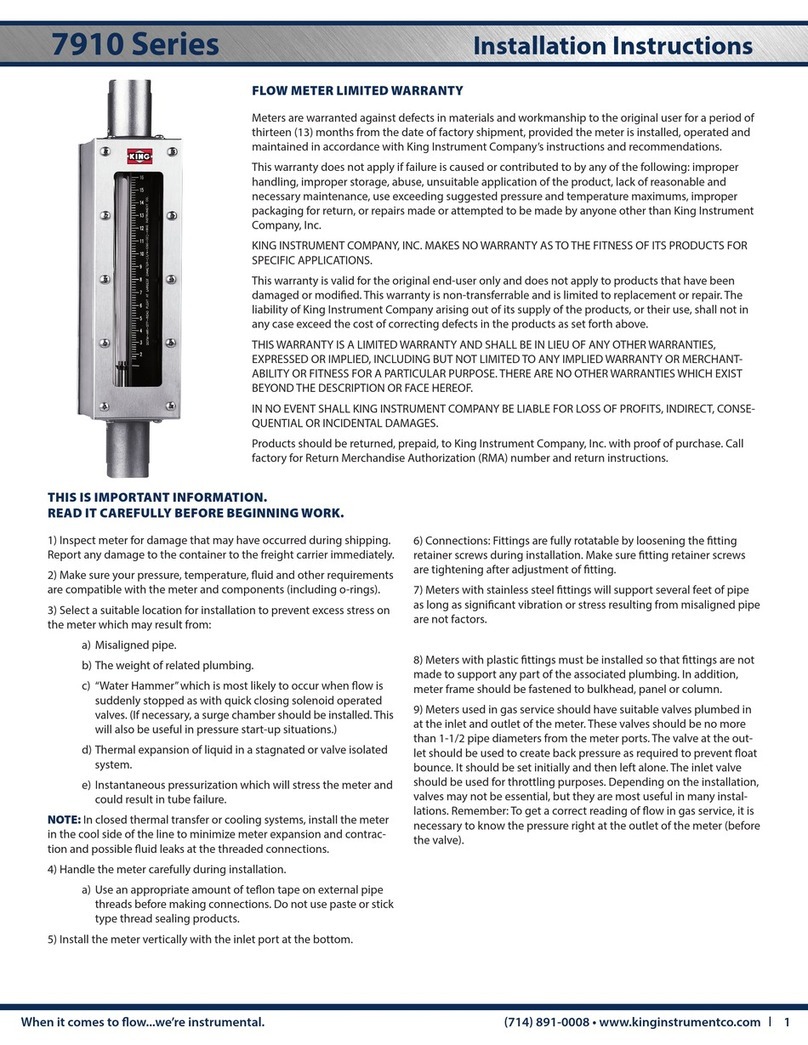
King Instrument
King Instrument 7910 Series installation instructions

Eilon Engineering
Eilon Engineering RON 2501 operating manual
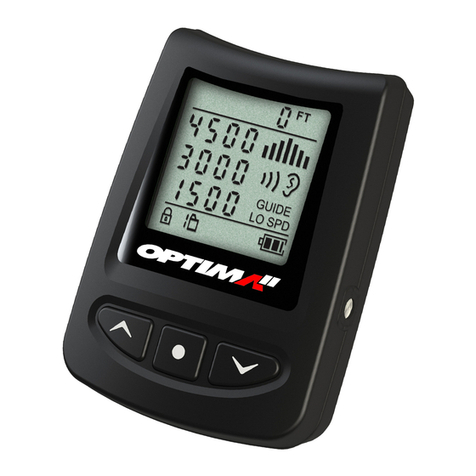
Larsen & Brusgaard
Larsen & Brusgaard OPTIMA II instruction manual
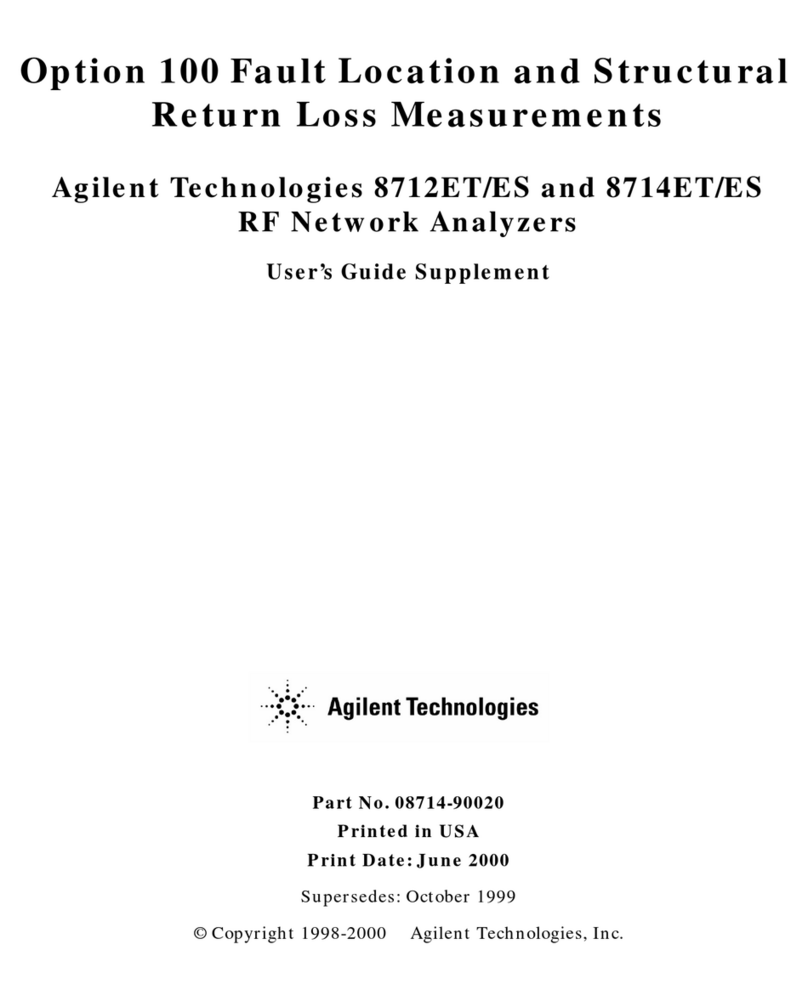
Agilent Technologies
Agilent Technologies 8712ET user guide

ROHRBACK COSASCO SYSTEMS
ROHRBACK COSASCO SYSTEMS CHECKMATE Reference manual
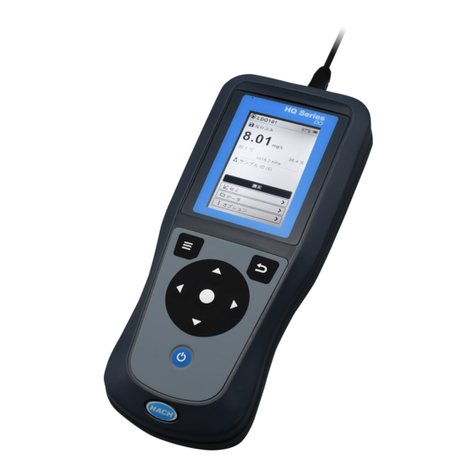
Hach
Hach HQ1110 Basic user manual


